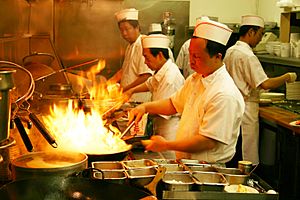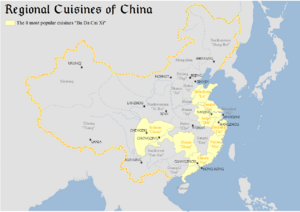Cantonese cuisine facts for kids
Quick facts for kids Cantonese cuisine |
|||||||||||||||
|---|---|---|---|---|---|---|---|---|---|---|---|---|---|---|---|

Chefs cook with a wok
|
|||||||||||||||
| Traditional Chinese | 廣東菜 | ||||||||||||||
| Simplified Chinese | 广东菜 | ||||||||||||||
| Cantonese Yale | Gwóng dūng choi | ||||||||||||||
|
|||||||||||||||
| Yue cuisine | |||||||||||||||
| Traditional Chinese | 粵菜 | ||||||||||||||
| Simplified Chinese | 粤菜 | ||||||||||||||
| Cantonese Yale | Yuht choi | ||||||||||||||
|
|||||||||||||||
Cantonese cuisine is a famous style of cooking from Guangdong province in China. It's also called Yue cuisine. This food style is especially popular in the capital city, Guangzhou, and nearby areas like Hong Kong and Macau.
Cantonese food is one of the eight main cooking traditions in China. It's well-known around the world because many Cantonese people have moved to other countries. Chefs who know how to cook Cantonese dishes are very popular in China. For a long time, most Chinese restaurants in Western countries mainly served Cantonese food.
What Makes Cantonese Food Special?
Guangzhou (Canton) City has always been a busy trading place. This means many different foods and ingredients have come into Cantonese cooking. Besides common meats like pork, beef, and chicken, Cantonese cuisine uses many other edible parts. These can include chicken feet, duck's tongue, and even frog legs. However, lamb and goat are not used as much as in other parts of China.
Cooking Methods
Cantonese chefs use many ways to cook food. The most popular methods are steaming and stir-frying. These ways are quick and easy. Other cooking styles include shallow frying, double steaming, braising, and deep frying.
Flavors and Spices
Compared to other Chinese foods, most traditional Cantonese dishes taste balanced and are not too oily. Chefs use only a little bit of spices. This is so the natural taste of the fresh ingredients can shine through. Cantonese cooking doesn't use many fresh herbs. But garlic chives and coriander leaves are sometimes used. Garlic chives are often cooked as a vegetable, and coriander is usually just a garnish.
Delicious Cantonese Dishes
Sauces and Seasonings
In Cantonese cooking, simple ingredients like sugar, salt, soy sauce, rice wine, corn starch, vinegar, scallion, and sesame oil are enough to make food taste great. Ginger, chili peppers, five-spice powder, and black pepper are also used, but usually not too much.
Some popular sauces and seasonings include:
- Hoisin sauce: A sweet and savory sauce often used with roasted meats.
- Oyster sauce: A thick, dark sauce made from oysters, used to add a savory flavor.
- Plum sauce: A sweet and sour sauce often served with roasted duck or spring rolls.
- Sweet and sour sauce: A classic sauce that balances sweet and tangy flavors.
-
Char siu is often marinated with plum sauce and honey for sweet flavour
-
Oysters steamed in two ways: with ginger and garlic, and in black bean sauce
Dried and Preserved Foods
Even though fresh ingredients are important, Cantonese cuisine also uses many preserved foods. These foods add strong flavors to dishes. Some foods are dried to make their flavors more intense or to help them last longer. Dried items are usually soaked in water before cooking.
Here are a few examples:
- Century egg: A preserved duck, chicken, or quail egg.
- Chinese sausage: A dried sausage, often added to rice.
- Dried scallops: Used to add a rich flavor to soups.
- Dried shrimp: Often mixed with stir-fried vegetables.
- Salted duck egg: Can be eaten alone or cooked with other dishes.
- Salted fish: Often paired with steamed pork or added to fried rice.
-
Deep-fried vegetarian goose wrapped in tofu skin
Classic Cantonese Dishes
Many dishes have been part of Cantonese cuisine for a very long time. You can find them in Cantonese restaurants or cooked in homes. Home-cooked Cantonese meals are usually served with plain white rice.
Some well-known dishes include:
- Cantonese style fried rice: A popular rice dish with various ingredients.
- Choy sum in oyster sauce: A simple vegetable dish.
- Congee with lean pork and century egg: A savory rice porridge.
- Steamed egg: A soft, savory egg custard.
- Sweet and sour pork: A famous dish with crispy pork in a tangy sauce.
Deep-Fried Delights
Cantonese cuisine also has some tasty deep-fried dishes. You can often find these as street food. They are popular for breakfast and lunch.
Some examples are:
- Dace fish balls: Fried fish balls.
- Chinese Donut: A long, golden-brown fried dough stick.
- Zaa Leung: Fried dough wrapped in rice noodle rolls.
Warming Soups
Old fire soup, or lou fo tong, is a special clear soup. It's made by cooking meat and other ingredients slowly for many hours over low heat. Chinese herbs are often added to these soups. This slow cooking helps the soup keep its original, rich taste.
Some popular Cantonese soups are:
- Cantonese seafood soup: A rich soup with various seafood.
- Night-blooming cereus soup: A unique soup made with a special flower.
- Winter melon soup: A light and refreshing soup.
Fresh Seafood Dishes
Guangdong province is on the coast, so fresh seafood is a big part of Cantonese food. Many Cantonese restaurants even have tanks with live seafood! The freshest seafood has no strong smell. Cantonese chefs often steam fresh seafood with just a little soy sauce, ginger, and spring onion. This light seasoning helps bring out the natural sweetness of the seafood. If a dish is very spicy, it often means the ingredients weren't as fresh.
Some seafood dishes include:
- Lobster with ginger and scallions: A flavorful lobster dish.
- Steamed fish: A simple yet delicious way to enjoy fresh fish.
- White boiled shrimp: Shrimp cooked simply to highlight their natural taste.
-
Typical ingredients for Cantonese style hotpot are razor shell (蟶子), crab (蟹), prawn (蝦), chicken sausage (雞肉腸仔) and dace fishball (魚旦)
Noodle Dishes
Noodles are a staple in Cantonese cuisine. They can be served in soup or stir-fried. You can find them as home-cooked meals, as part of dim sum, or as street food at places called dai pai dongs. They often come with toppings like fish balls or beef balls.
Some famous noodle dishes are:
- Beef brisket noodles: Noodles served with tender beef brisket.
- Beef chow fun: Wide rice noodles stir-fried with beef.
- Chow mein: A general term for various stir-fried noodle dishes.
- Wonton noodles: Noodles served with delicious wontons (dumplings).
Siu Mei (Roasted Meats)

Siu mei is the Chinese style of roasted meats, similar to rotisserie cooking. Unlike most other Cantonese dishes, siu mei usually only has meat, no vegetables.
Popular siu mei dishes include:
- Char siu: Sweet and savory roasted pork.
- Roast duck: Crispy-skinned roasted duck.
- Roast goose: A very popular roasted goose dish.
- Roast pig: Roasted pork with crispy skin.
Siu Laap (Cooked Meats)
Siu laap is a general term for all Cantonese-style cooked meats. This includes siu mei and other preserved meats. Most siu laap dishes are made from white meat.
Some siu laap dishes are:
- Chicken in soy sauce: Chicken cooked in a savory soy sauce.
- White cut chicken: Chicken that is poached (gently cooked in liquid) and served simply.
Little Pot Rice

Little pot rice (bou zai faan) dishes are cooked and served in a special flat-bottomed pot, often a clay pot. The ingredients are layered on top of the rice and then steamed. This makes the rice and ingredients very hot and soft.
Some common little pot rice dishes are:
- Rice with Chinese sausage and preserved meat.
- Rice with layered egg and beef.
- Rice with spare ribs.
Dinner and Banquet Dishes
Some dishes are traditionally served in Cantonese restaurants only at dinner. These dishes can be standard or special, like those made for Chinese marriages or big parties. Salt and pepper dishes are some of the few spicy options.
Examples include:
- Crispy fried chicken: A whole chicken fried until crispy.
- Roast suckling pig: A whole young pig roasted until its skin is very crispy.
- Shrimp with salt and pepper: Shrimp seasoned with salt and pepper, often fried.
- Yangzhou fried rice: A famous fried rice dish with different meats and vegetables.
Sweet Desserts (Tong Sui)
After dinner, most Cantonese restaurants offer tong sui, which means "sweet soup." There are many kinds of tong sui. Some are old traditions, while others are new creations. Tong sui is made by adding water and sugar to other ingredients.
Some popular tong sui desserts are:
- Black sesame soup: A warm, thick, sweet soup made from black sesame seeds.
- Coconut pudding: A sweet, jiggly pudding made with coconut milk.
- Mung bean soup: A sweet soup made from mung beans.
- Red bean soup: A classic sweet soup made from red beans.
- Tofu flower pudding: A very soft, silky tofu dessert.
Images for kids
-
Roast pigeon
-
Rice with Chinese sausage and char siu
-
Roast pigeon
-
Spare ribs with salt and pepper
-
Mung bean soup
See also
 In Spanish: Gastronomía de Cantón para niños
In Spanish: Gastronomía de Cantón para niños



































